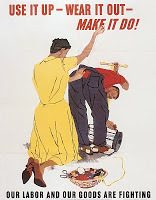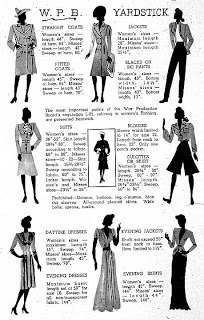Sarah Sundin's Blog, page 526
April 2, 2011
Today in World War II History
70 Years Ago—Apr. 2, 1941: RAF drops 75,000 tea bags in Holland to increase Dutch morale. Clash between union and non-union miners in Harlan KY leaves four dead.
Published on April 02, 2011 03:00
April 1, 2011
Today in World War II History
70 Years Ago—Apr. 1, 1941: In Iraq, Rashid Ali seizes control from Regent Faisal and sets up a pro-Axis government.
Published on April 01, 2011 03:00
March 31, 2011
Today in World War II History
70 Years Ago—Mar. 31, 1941: RAF first uses 4000-lb "Cookie" bomb against Emden, Germany. Rommel's German troops attack British and take Mersa Brega, Libya.
Published on March 31, 2011 03:00
March 30, 2011
Book Beat - Letters from Home
 Readers often tell me they'd like to see more fiction set during World War II, so I like to highlight novels featuring this dramatic period in history. I e-met Kristina McMorris through a mutual writing friend, and we've enjoyed sharing research tidbits. I was thrilled at the chance to read her debut novel, Letters from Home, which released this month. In Letters from Home, literature student Liz Stephens meets Private Morgan McClain at a USO dance. Although she senses a connection and attraction to Morgan, she believes he's interested in her perky roommate, Betty. Besides, Liz is practically engaged to her childhood sweetheart. When Betty, who is not particularly articulate, begs Liz to write a letter to Morgan for her, Liz reluctantly agrees, not knowing that the correspondence between Morgan and "Betty" will change both of their lives. The novel follows Morgan through Normandy and the Battle of the Bulge, Liz as she balances her father's expectations with her own dreams, Liz's roommate Julia as she juggles dual dreams of a career in fashion design and a home with her sailor fiance after the war, and Betty as she joins the Women's Army Corps and finds herself a hospital attendant in the jungles of New Guinea. McMorris has written a romantic novel with compelling characters. The writing is lovely and the research is meticulous. I was completely drawn in to each of the subplots. Warning for my more sensitive readers: there are quite a few cuss words, especially among the military men, and two steamy scenes on a "PG-13" level. However, there is a hopeful spirit rare in mainstream literature, and the characters actually pray! I highly recommend this novel if you love to lose yourself in this time period, and I'm looking forward to McMorris's next book, also set during World War II.
Readers often tell me they'd like to see more fiction set during World War II, so I like to highlight novels featuring this dramatic period in history. I e-met Kristina McMorris through a mutual writing friend, and we've enjoyed sharing research tidbits. I was thrilled at the chance to read her debut novel, Letters from Home, which released this month. In Letters from Home, literature student Liz Stephens meets Private Morgan McClain at a USO dance. Although she senses a connection and attraction to Morgan, she believes he's interested in her perky roommate, Betty. Besides, Liz is practically engaged to her childhood sweetheart. When Betty, who is not particularly articulate, begs Liz to write a letter to Morgan for her, Liz reluctantly agrees, not knowing that the correspondence between Morgan and "Betty" will change both of their lives. The novel follows Morgan through Normandy and the Battle of the Bulge, Liz as she balances her father's expectations with her own dreams, Liz's roommate Julia as she juggles dual dreams of a career in fashion design and a home with her sailor fiance after the war, and Betty as she joins the Women's Army Corps and finds herself a hospital attendant in the jungles of New Guinea. McMorris has written a romantic novel with compelling characters. The writing is lovely and the research is meticulous. I was completely drawn in to each of the subplots. Warning for my more sensitive readers: there are quite a few cuss words, especially among the military men, and two steamy scenes on a "PG-13" level. However, there is a hopeful spirit rare in mainstream literature, and the characters actually pray! I highly recommend this novel if you love to lose yourself in this time period, and I'm looking forward to McMorris's next book, also set during World War II.
Published on March 30, 2011 05:00
Today in World War II History
70 Years Ago—Mar. 30, 1941: US seizes 65 Axis ships in US ports.
Published on March 30, 2011 03:00
March 29, 2011
Today in World War II History
70 Years Ago—Mar. 29, 1941: British take Dire Dawa in Ethiopia.
Published on March 29, 2011 03:00
March 28, 2011
Make It Do - Clothing Restrictions in World War II

 During World War II, the United States didn't ration clothing as the United Kingdom did, but restrictions were applied, and fashions adapted to use less fabric. Why Clothing? Eleven million men and women served in the US military during the war, and they all needed uniforms. This strained the country's supply of fabric, particularly wool, and the garment manufacturing system. Since Japan produced the majority of the world's silk, the war cut off the supply completely. Civilians were encouraged to purchase or make clothing from cotton, rayon, or rayon/wool blends. Wartime Women's Fashions Clothing using less fabric became fashionable. Women's suits took on a sleek, military look. Suit jackets were fitted, with padded shoulders, and rested between the waist and hip. Skirts took on a slim silhouette, often with an A-line flare. The peasant look was also popular, but without full skirts and ruffles. Also, millions of women entering the workplace popularized the "Rosie the Riveter" look—slacks became stylish, as well as turbans, snoods, and headscarves to keep hair away from machinery. Since metal zippers were unavailable, wraparound dresses and skirts were introduced.
During World War II, the United States didn't ration clothing as the United Kingdom did, but restrictions were applied, and fashions adapted to use less fabric. Why Clothing? Eleven million men and women served in the US military during the war, and they all needed uniforms. This strained the country's supply of fabric, particularly wool, and the garment manufacturing system. Since Japan produced the majority of the world's silk, the war cut off the supply completely. Civilians were encouraged to purchase or make clothing from cotton, rayon, or rayon/wool blends. Wartime Women's Fashions Clothing using less fabric became fashionable. Women's suits took on a sleek, military look. Suit jackets were fitted, with padded shoulders, and rested between the waist and hip. Skirts took on a slim silhouette, often with an A-line flare. The peasant look was also popular, but without full skirts and ruffles. Also, millions of women entering the workplace popularized the "Rosie the Riveter" look—slacks became stylish, as well as turbans, snoods, and headscarves to keep hair away from machinery. Since metal zippers were unavailable, wraparound dresses and skirts were introduced.
 Wartime Men's Fashions Before the war, when a man purchased a suit, it came with a jacket, a vest, and two pairs of pants. The wartime "Victory Suit" eliminated the vest and second pair of pants. Men's suits were single-breasted, had narrow lapels, no cuffs, and no pocket flaps. Wartime necessity allowed men to wear mismatched jackets and trousers. War Production Board Restrictions
Wartime Men's Fashions Before the war, when a man purchased a suit, it came with a jacket, a vest, and two pairs of pants. The wartime "Victory Suit" eliminated the vest and second pair of pants. Men's suits were single-breasted, had narrow lapels, no cuffs, and no pocket flaps. Wartime necessity allowed men to wear mismatched jackets and trousers. War Production Board Restrictions
 On March 8, 1942, the US War Production Board (WPB) issued order L-85 with the goal of 15 percent reduction in the amount of textiles used in women's wear. Skirt length and width were restricted, as well as the width of women's slacks. The WPB prohibited pleats, ruffles, patch pockets, attached hoods and shawls, and full sleeves or skirts. Hems and fabric belts could be no wider than two inches, and garments could have no more than one pocket. Exemptions were allowed for bridal gowns, maternity clothes, and religious vestments. Home sewing was not restricted and became even more popular. However, patterns of the time tended to follow WPB guidelines. Price Controls The textile situation worsened in 1944. Manufacturing of civilian clothing fell 50 percent, and prices began to rise. To prevent rampant inflation, the Office of Price Administration instituted price controls on clothing on March 19, 1945, which were lifted on August 18, 1945. Making Do Mending was more than economical, it was a patriotic duty, and a fad for patched clothing emerged. Home sewers often pieced together garments from remnants, mixing and matching colors and patterns. Creative women cut down old garments to reuse the cloth and remade old clothing into wartime fashions. Due to the silk shortage, women shared wedding dresses and formalwear. With so many men off to war, wives were encouraged to remake their husband's suits for their own use, and the old pioneer tradition of cutting down adult clothing for children's use returned. What do you think of 1940s fashions? Would you have resented the restrictions or enjoyed the chance to be creative?
On March 8, 1942, the US War Production Board (WPB) issued order L-85 with the goal of 15 percent reduction in the amount of textiles used in women's wear. Skirt length and width were restricted, as well as the width of women's slacks. The WPB prohibited pleats, ruffles, patch pockets, attached hoods and shawls, and full sleeves or skirts. Hems and fabric belts could be no wider than two inches, and garments could have no more than one pocket. Exemptions were allowed for bridal gowns, maternity clothes, and religious vestments. Home sewing was not restricted and became even more popular. However, patterns of the time tended to follow WPB guidelines. Price Controls The textile situation worsened in 1944. Manufacturing of civilian clothing fell 50 percent, and prices began to rise. To prevent rampant inflation, the Office of Price Administration instituted price controls on clothing on March 19, 1945, which were lifted on August 18, 1945. Making Do Mending was more than economical, it was a patriotic duty, and a fad for patched clothing emerged. Home sewers often pieced together garments from remnants, mixing and matching colors and patterns. Creative women cut down old garments to reuse the cloth and remade old clothing into wartime fashions. Due to the silk shortage, women shared wedding dresses and formalwear. With so many men off to war, wives were encouraged to remake their husband's suits for their own use, and the old pioneer tradition of cutting down adult clothing for children's use returned. What do you think of 1940s fashions? Would you have resented the restrictions or enjoyed the chance to be creative?
Published on March 28, 2011 05:00
Today in World War II History
70 Years Ago—Mar. 28, 1941: Battle of Matapan: British ships sink 5 Italian ships south of Crete, 3000 killed; Italian navy rarely ventures from port after this. Writer Virginia Woolf dies.
Published on March 28, 2011 03:00
March 27, 2011
Today in World War II History
70 Years Ago—Mar. 27, 1941: Military coup in Yugoslavia deposes Axis regent Prince Paul. US signs 99-year lease on British bases in the western hemisphere in exchange for $7 billion in aid under the Lend-Lease agreement. US & UK sign ABC-1 Agreement to protect convoys and prepare for potential US entry into war.
Published on March 27, 2011 03:00
March 26, 2011
Today in World War II History
70 Years Ago—Mar. 26, 1941: Italians attack British ships at Suda Bay, Crete with the first use of manned torpedoes with detachable warhead in history. US forms First, Second, Third, and Fourth Air Forces based in the continental US. British meat ration reduced to 6oz per week.
Published on March 26, 2011 03:00



